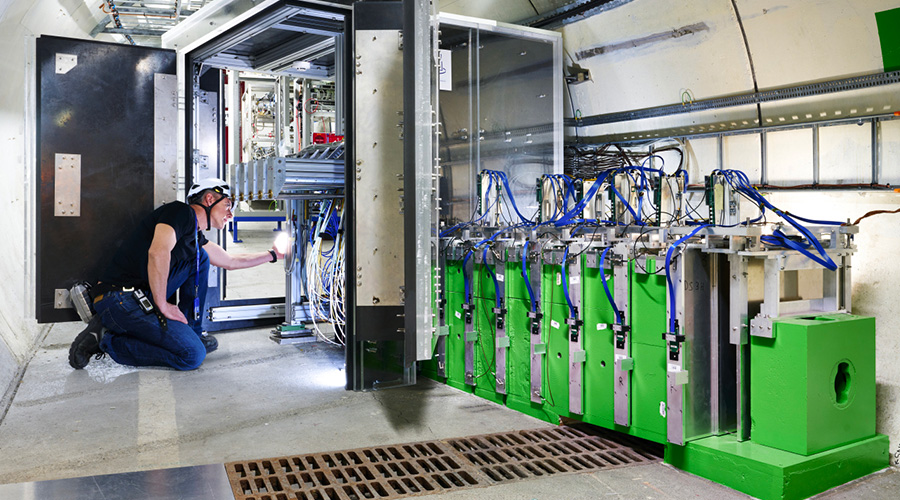
The goal of the international collaboration SND@LHC, which involves a significant contribution from INFN, is to use CERN’s Large Hadron Collider as a source for studying neutrinos, elementary particles characterised by their very weak interaction with matter, emitted as a result of proton collisions inside the super accelerator. Having completed the production of its experimental apparatus in March last year, the researchers of SND@LHC, together with colleagues from the FASER collaboration (another experiment at CERN that studies neutrinos), published on July 29 in the journal Physical Review Letters. This includes the first results of the analysis of the data acquired during 2022, which reveal the first observation of high-energy muon neutrinos produced in the LHC. As well as opening a window of investigation into the properties of neutrinos, the measurement, which is the first of its kind, is an important technological success. It confirms the capacity of the detection system adopted by SND@LHC to identify very elusive particles. Approved in March 2021, the Scattering and Neutrino Detector (SND@LHC) experiment was installed 480 m from the ATLAS experiment in a previously unused tunnel that connects the LHC to the SPS. Its purpose is to identify and study a high number of neutrinos of all three flavours (electron, muon, and tau) that a collider like the LHC is able to produce. Until now, these have escaped direct observation due to their low probability of interaction and their trajectory parallel to the axis of collision, which makes these neutrinos “invisible” to the other LHC experiments. Until now, the LHC experiments have associated the presence of neutrinos with the detection of missing energy in reconstructing the products of interactions. SND@LHC was designed with the goal of detecting these particles, which are of great interest to physics since characterised by very high energies not yet explored. SND@LHC has smaller dimensions compared to the other types of experiments dedicated to studying neutrinos currently underway. It consists of two regions. In the upstream region, there are tungsten plates with an overall weight of approximately 800 kg. These alternate nuclear emulsion films, able to detect the interaction of neutrinos extremely precisely, with electron tracking systems, based on scintillating fibres for measuring the moment when the interaction events occur and their electromagnetic energy. The final region of the experiment is, instead, equipped with a hadron calorimeter and a muon recognition system. It was possible to produce experimental equipment for neutrinos with small dimensions for the high number of LHC collisions, which translate into an equally high flow of neutrinos in the forward direction. The large number of neutrinos and their high energies, whose increase corresponds to a greater probability of interaction, make their detection possible even with more compact equipment than that used in investigating neutrinos today thanks, in part, to the relative proximity of the source detector. Thanks to its characteristics, SND@LHC was able to identify only those events owing to the interaction between the experimental equipment and neutrinos produced by the accelerator in the sample of data acquired in 2022, consisting of several billion muons. SND@LHC has observed 8 muon neutrino interaction candidate events, with a statistical significance above 5 sigma, which is needed to confirm an observation in physics. With these first results of the analysis of data collected in 2022, the SND@LHC experiment has opened a new frontier in studying neutrinos and searching dark matter. Given that a good part of the neutrinos originated from the decay of heavy quarks, these constitute a unique way of studying the production of these quarks, which is inaccessible to other experiments. These measurements are also significant for predicting the flow of very high-energy neutrinos produced in cosmic rays, since the experiment bridges the gap between accelerator and astroparticle physics. INFN has a central role in the collaboration with the groups of the Universities and the Bari, Bologna, and Naples INFN Divisions. In fact, INFN constructed the neutrino target and the muon identification system of the experiment and is currently in charge of data analysis. This result opens up a new era, that of collider neutrino physics; this is a new research thread that, based on its recognised expertise in this research sector, INFN has contributed to inaugurating. This is the first result: the investigation will continue with the study of muon neutrinos at higher statistics and with the detection of electron and tau neutrinos, as well as with the research into dark matter, thanks to the unique features of the experimental apparatus.





